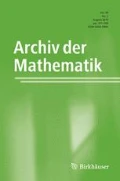Abstract.
Let D denote a positive nonsquare integer. Ljunggren has shown that there are at most two solutions in positive integers (x, y) to the Diophantine equation x 2–Dy 4 = 1, and that if two such solutions (x 1, y 1), (x 2, y 2) exist, with x 1≤x 2, then \(x_1+y_1^2\sqrt {D}\) is the fundamental unit \(\epsilon _{D}\) in the quadratic field \({\Bbb Q}(\sqrt {D})\), and \(x_2+y_2^2\sqrt {D}\) is either \(\epsilon _{D}^2\) or \(\epsilon _{D}^4\). The purpose of this note is twofold. Using a recent result of Cohn, we generalize Ljunggren’s theorem. We then use this generalization to completely solve the Diophantine equations x 2–kxy 2 + y 4 = 1, 4.
Similar content being viewed by others
Author information
Authors and Affiliations
Additional information
Received: 7.4.1998; final version received 20.1.1999.
Rights and permissions
About this article
Cite this article
Walsh, G. A note on a theorem of Ljunggren and the Diophantine equations x2–kxy2 + y4 = 1, 4. Arch. Math. 73, 119–125 (1999). https://doi.org/10.1007/s000130050376
Issue Date:
DOI: https://doi.org/10.1007/s000130050376


